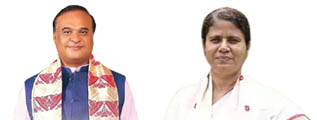The ASCPCR Members’ visit to Children homes in Kamrup (Metro) on August 8, 2017
On August 8th 2017, Tuesday, a team of the Assam State Commission for Protection of Child Rights (ASCPCR) made a surprise visit to three Child Care institutions, in different localities of the city under the banner of Snehalaya. The team comprised of Mr. Gopal Sharma (Member, ASCPCR), Mrs. Indrani Tahbildar (Member, ASCPCR), Mr. Maharishi Goswami (Technical Consultant) and Dr. Rashmi Sarmah (State Coordinator, BBA).
The Commission records its findings as follows:
1. The team first visited the Snehalaya Boys Home in Dhirenpara, where they met one of the staff members, Brother Ranjan Ekka. The home has a capacity for 50 boys, while presently only 42 are living there. The campus was spacious.
• The team observed that the files of the children staying in the homes were incomplete. Necessary documents like, CWC order or Individual Child Care Plan were missing, apart from incomplete data in the registers available.
• It was also seen that the renewal of registration for the home, mandatory under Section 41 of Juvenile Justice Act, 2015, was not done.
• As per the Rule 29 of Juvenile Justice (Care and Protection of Children) Model Rules, 2016, for standard of care of CCIs, the storage facility for the food in the house was very unhygienic and not proper. Also the dormitories did not have proper lockers or cupboards for the residents. The reading room also did not have enough space.
• Under Rule 30, Juvenile Justice (Care and Protection of Children) Model Rules, 2016 the clothing and bedding facilities in which the children have to be provided proper bed clothes as per the need and climatic condition of the place. Most of the beds in the dormitories lacked bed sheets and bed covers. The mattress was covered with only blankets.
• Under Rule 31, Juvenile Justice (Care and Protection of Children) Model Rules, 2016toilets were enough in number but proper hygiene was not there as the residing area was stinking.
• Under Rule 32, Juvenile Justice (Care and Protection of Children) Model Rules, 2016the daily routine missed Vocational Training of any kind for the boys.
Most of the boys had gone to school, so the team spoke to a very few who had missed school that day. The boys did not speak much about their life in the home.
Though one of the senior boys enthusiastically displayed some craft work he had done and also told the team that he and some of his friends did the cooking for all on the day as the cook was on leave. All the children were enrolled in school and had time and space for sports activities.
The team though met some volunteers and staff along with children at the home who had been enrolled under the Snehlaya scheme of ‘Child Friendly Guwahati’ for school dropout street children and Special Training Center for economically deprived children. The children voluntarily performed songs and recited poetry for the ASCPCR team members.
2. Snehalaya Center for Child Rights, Paltan Bazaar, where the head office of Snehalaya is situated. There the members met Father Thaddeus Kujur, the director and Miss Anamika Barua, a staff. The home had 45 boys residing there.
• Father Kujur and Ms Barua were told about the unavailability of proper documents in some of their centers, to which they explained that all children related documents and files are maintained in the head office there. On this they were advised to at least provide photocopy of those in the respective centers for reference to the authorities when required, under the JJ Act, to which they agreed.
• They were also reminded of the need for registration of each of their homes and also renewal of registration where necessary.
• On inspection of the dormitories and the rest of the facility, it was observed that once again the Institution had failed to provide proper infrastructure to the residing children. Not enough lockers were provided nor was the washroom and toilet area maintained well.
• In case of clothing and bedding, the beds did not have proper bed clothes, and the lockers were in very shabby condition.
• The other facilities though, like, reading area, computer room and recreation room were in proper shape.
• The team inspected the documents of children residing in different branches of Snehalaya which was already visited by the ASCPCR team, apart from files of those residing in that particular facility and found it satisfactory.
3. The team finally went to the Auxillium Snehalaya, Noonmati, a facility for the girl children. The number of girls residing there was 26, between the age group of 6 to 13. Sister Martina, the in-charge took the team around the building.
• The infrastructure and Hygiene conditions were taken care of well. The beds had proper bed clothes and the wash rooms and toilets were clean and in ample number.
• The reading and recreation rooms had enough space. The dormitories were clean and the children also maintained proper hygiene.
• Two different dormitories were available for children divided into two age categories.
• All the children residing there were being provided with formal education and recreational activities.
Suggestions by the visiting ASCPCR Team
1. The infrastructure and hygiene conditions in the dormitories for Snehalaya homes at Dhirenpara and Paltan Bazaar need to be improved in order to provide a clean, spacious, child friendly environment for the growth and development of the children there.
2. Vocational training facilities need to be provided in a proper manner to the inmates.
3. Maintenance of records and files of the children needs to be done more systematically.
4. The Auxillium Snehalaya at Noonmaati needs to have a proper signboard for itself.

